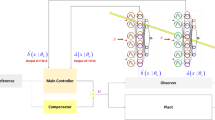Abstract
Type-2 fuzzy logic systems are an area of growing interest over the last years. The ability to model uncertainties and to perform under noisy conditions in a better way than type-1 fuzzy logic systems increases their applicability. A new stable on-line learning algorithm for interval type-2 Takagi–Sugeno–Kang (TSK) fuzzy neural networks is proposed in this paper. Differently from the other recently proposed variable structure system theory-based on-line learning approaches for the type-2 TSK fuzzy neural nets, where the adopted consequent part of the fuzzy rules consists solely of a constant, the developed algorithm applies the complete structure of the Takagi–Sugeno type fuzzy if–then rule base (i.e. first order instead of zero order output function is implemented). In addition it is able to adapt the existing relation between the lower and the upper membership functions of the type-2 fuzzy systems. This allows managing of non-uniform uncertainties. Simulation results from the identification of a nonlinear system with uncertainties and a non-bounded-input bounded-output nonlinear plant with added output noise have demonstrated the better performance of the proposed algorithm in comparison with the previously reported in the literature sliding mode on-line learning algorithms for both type-1 and type-2 fuzzy neural structures.










Similar content being viewed by others
References
Biglarbegian M, Melek W, Mendel JM (2010) On the stability of interval type-2 tsk fuzzy logic control systems. IEEE Trans Syst Man Cybern B Cybern 40(3):798–818
Cascella G, Cupertino F, Topalov A, Kaynak O, Giordano V (2005) Adaptive control of electric drives using sliding-mode learning neural networks. IEEE Int Symp Ind Electron 1:125–130
Castillo O, Melin P, Montiel O, Rodriguez-Diaz A, Sepulveda R (2005) Handling uncertainty in controllers using type-2 fuzzy logic. J Intell Syst 14(3):237–262
Garibaldi JM, Ozen T (2007) Uncertain fuzzy reasoning: a case study in modelling expert decision making. IEEE Trans Fuzzy Syst 15(1):16–30
Hagras HA (2004) A hierarchical type-2 fuzzy logic control architecture for autonomous mobile robots. IEEE Trans Fuzzy Syst 12(4):524–539
Karnik NN, Mendel JM, Liang Q (1999) Type-2 fuzzy logic systems. IEEE Trans Fuzzy Syst 7(6):643–658
Kayacan E, Cigdem O, Kaynak O (2011) A novel training method based on variable structure systems approach for interval type-2 fuzzy neural networks. In: IEEE symposium series on computational intelligence, SSCI, Paris, pp 142–149
Khanesar MA, Kayacan E, Teshnehlab M, Kaynak O (2011) Analysis of the noise reduction property of type-2 fuzzy logic systems using a novel type-2 membership function. IEEE Trans Syst Man Cybern 41(5):1395–1405
Ku CC, Lee K (1995) Diagonal recurrent neural networks for dynamic systems control. IEEE Trans Neural Netw 6(1):144–156
Li L, Lin W-H, Liu H (2006) Type-2 fuzzy logic approach for short-term traffic forecasting. Proc Inst Elect Eng Intell Transp Syst 153(1):33–40
Lin CT, George Lee CS (1996) Neural fuzzy systems. Englewood Cliffs, NJ
Mendel JM (2000) Uncertainty, fuzzy logic, and signal processing. Signal Process 80(6):913–933
Mendel JM (2001) Uncertain rule-based fuzzy logic systems. Prentice Hall, Los Angeles
Mendel JM, John R (2002) Type-2 fuzzy sets made simple. IEEE Trans Fuzzy Syst 10(2):117–127
Mitchell HB (2005) Pattern recognition using type-II fuzzy sets. Inf Sci 170:409–418
Sepulveda R, Castillo O, Melin P, Rodriguez-Diaz A, Montiel O (2007) Experimental study of intelligent controllers under uncertainty using type-1 and type-2 fuzzy logic. Inf Sci 177(10):2023–2048
Shakev N, Topalov AV, Kaynak O (2008) A neuro-fuzzy adaptive sliding mode controller: application to second-order chaotic system. In: IS 2008, IEEE international conference on intelligent systems, Varna, pp 9.14–9.19
Shiev K, Shakev N, Topalov AV, Ahmed S, Kaynak O (2011) An extended sliding mode learning algorithm for type-2 fuzzy neural networks. In: Bouchachia A (ed) Adaptive and intelligent systems, LNAI, vol 6943, Springer, Heidelberg, pp 52–63
Suykens JAK, Vandewalle J, De Moor B (1999) Lur’e systems with multilayer perceptron and recurrent neural networks: absolute stability and dissipativity. IEEE Trans Autom Control 44:770–774
Topalov AV. Kaynak O, Shakev N, Hong SK (2008) Sliding mode algorithm for on-line learning in fuzzy rule-based neural networks. In: Proceedings of the 17th IFAC world congress, Seoul, pp 12793–12798
Utkin VI (1992) Sliding modes in control and optimization. Springer, Berlin
Wu H, Mendel JM (2007) Classification of battlefield ground vehicles using acoustic features and fuzzy logic rule-based classifiers. IEEE Trans Fuzzy Syst 15(1):56–72
Yu S, Yu X, Man Z (2004) A fuzzy neural network approximator with fast terminal sliding mode and its applications. Fuzzy Sets Syst 148:469–486
Acknowledgments
The work of N. Shakev, A. V. Topalov and K. Shiev was supported in part by the TU Sofia Research Fund Project 112pd009-19 and in part by the Ministry of Education, Youth and Science of Bulgaria Research Fund Project BY-TH-108/2005. The work of O. Kaynak was supported by the TUBITAK Project 107E248.
Author information
Authors and Affiliations
Corresponding author
Rights and permissions
About this article
Cite this article
Ahmed, S., Shakev, N., Topalov, A. et al. Sliding mode incremental learning algorithm for interval type-2 Takagi–Sugeno–Kang fuzzy neural networks. Evolving Systems 3, 179–188 (2012). https://doi.org/10.1007/s12530-012-9053-6
Received:
Accepted:
Published:
Issue Date:
DOI: https://doi.org/10.1007/s12530-012-9053-6




